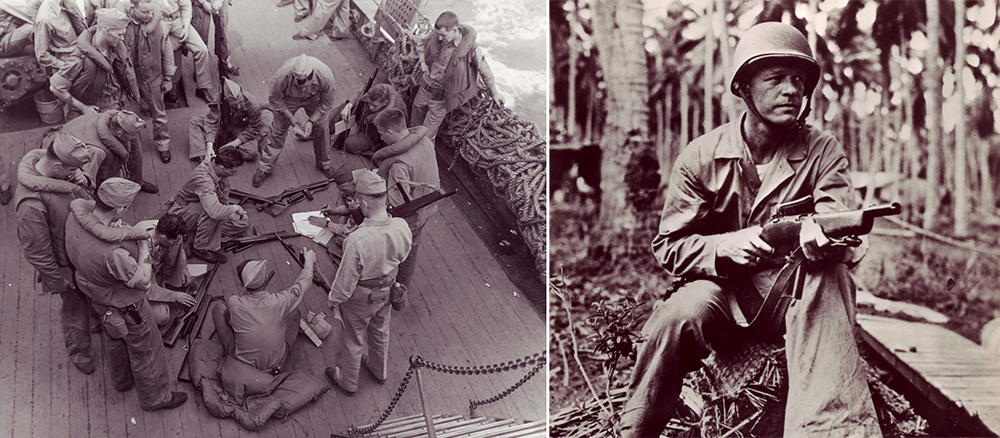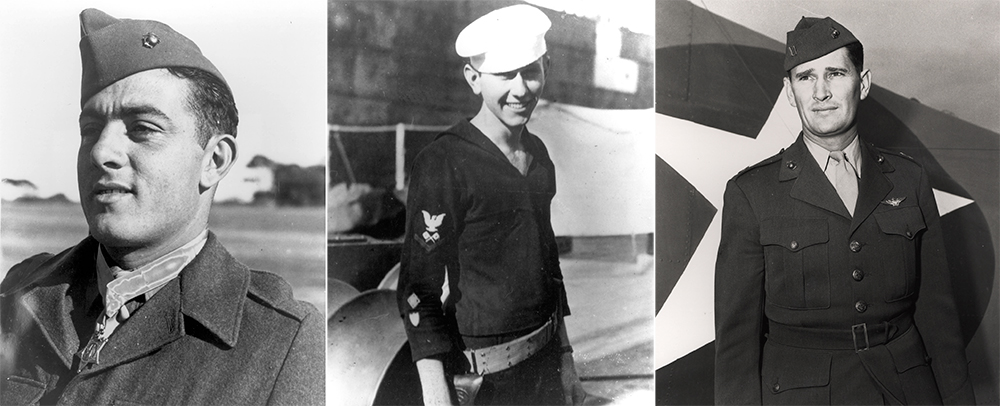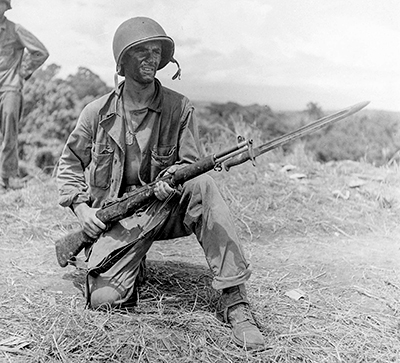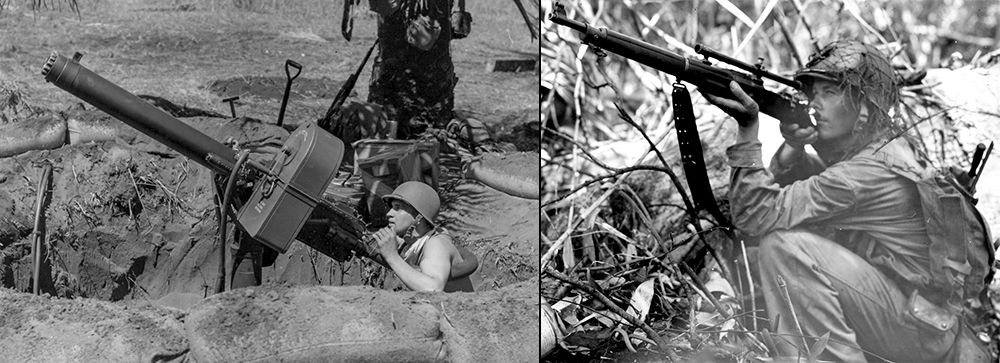
In January 1942, the Japanese Imperial Army and Navy captured the port of Rabaul, New Britain, and from there, the next major objective was establishing outposts in the British Solomon Islands Protectorate. Those outposts created a contiguous chain of airfields that would make it possible for multi-engine aircraft to reach the shipping lanes connecting the United States to Australia. When Imperial Marines seized Tulagi in the southern part of the Solomon Archipelago at the beginning of May 1942, the Japanese had no reason to expect anything other than more of the same success they had been experiencing since the war began. But Tulagi was not spacious enough to accommodate a proper airfield for ground-based bombers, so, in early July, they began building one at the mouth of the Lunga River on nearby Guadalcanal. The construction of that airfield set the stage for an epic air, sea and land battle that pitted American and Japanese forces against one another in the decisive campaign of the Pacific war. For six months, this battle was fought on one side with guns designed by Isaac Newton Lewis, John Browning and John Garand, and on the other side with guns designed by Nariakira Arisaka and Kijiroˉ Nambu.
The amphibious operation began when a U.S. Navy task force put the 1st Marine Division ashore on Aug. 7, 1942. Three thousand Marines were landed on Tulagi while the rest of the division was landed between Koli Point and Lunga Point on the north coast of Guadalcanal. In contrast to the heavy opposition that the Japanese presented on Tulagi, almost no opposition confronted the landings on Guadalcanal, and the Japanese airfield—still under construction at the time—was secured by the afternoon. Tulagi was secured the following day, but the Japanese were not about to let the area pass to the Americans without a fight. Aircraft from Rabaul began flying bombing missions almost immediately, and then the Japanese scored a major naval victory in the Battle of Savo Island during the night of Aug. 8. As a result of this, the U.S. Navy was forced to withdraw from the area, even though less than half of the 1st Marine Division’s supplies had been unloaded. This would create a critical situation during the weeks that followed as ground combat operations began on Guadalcanal, because the Marines would have to make do with only what had been delivered ashore at the Lunga Point beachhead. The first order of business after the landings was to get the airfield operational, and that task was completed by Aug. 12. They christened it Henderson Field in honor of Marine Maj. Lofton R. Henderson, who was killed in action during the Battle of Midway, and it sat in the center of the Marine perimeter at Lunga Point.

Shortly after Henderson Field became operational, Navy, Marine Corps and Army aircraft started flying combat missions from it. Because Guadalcanal had the code name “Cactus,” the aircraft based there were ultimately given the nickname the Cactus Air Force. During the first two weeks, they went after targets on land and at sea while the ground forces fought a series of initial skirmishes with Japanese forces that were already on the island when the Marines landed. But a Japanese counterattack was already in the making. Shortly after midnight on Aug. 19, 917 soldiers of Col. Kiyonao Ichiki’s 28th Infantry Regiment landed 22 miles east of Henderson Field and began the westward trek toward the mouth of the Lunga. Tipped-off that a Japanese force was approaching, the Marines were ready behind defensive positions just west of Henderson Field near the mouth of the Ilu River, which they nicknamed Alligator Creek. Two battalions of the 1st Marine Regiment were waiting when Col. Ichiki’s detachment reached their positions shortly after midnight on Aug. 21. The Japanese walked into a wall of fire at the sandbar near the mouth of the river, and that fire was produced by a pair of 37 mm anti-tank guns firing canister rounds. In addition to that, Ichiki’s men were hammered by unrelenting fire from the most valuable U.S. infantry weapon to fight on Guadalcanal: the Browning .30-cal. M1917A1 heavy machine gun. Over and over again during the campaign, the M1917A1 saved the day. That night on Alligator Creek, Pvt. Al Schmid from 2nd Battalion/1st Marines (2/1) kept one of the guns running, despite having received multiple serious wounds. He was later awarded the Navy Cross for the action. Two months later, during the Japanese counteroffensive known as the Battle of Henderson Field, John Basilone of 1/7 and Mitchell Paige of 2/7 used M1917A1 machine guns to such great effect that they were both awarded the Medal of Honor. On Nov. 1, Pvt. Anthony Casamento of 1/5 continued running an M1917A1 from a firing position on Hill 78 to the west of the airfield, despite his multiple wounds; he was likewise awarded the Medal of Honor. The M1917A1’s ability to deliver sustained supporting fire in a defensive situation made it an indispensable tool in opposing the three Japanese counterattacks that attempted to re-capture the airfield at Lunga Point.

The M1917A1 was not the only Browning machine gun to fight on Guadalcanal. His M1919A4 .30-cal. light machine gun equipped ground forces, his ANM2 .30-cal. “Stinger” armed combat aircraft and his .50-cal. heavy machine gun was there in three different versions. For use on the ground, the M2HB air-cooled .50 served the perimeter-defense role, and the M2WC water-cooled .50 served the anti-aircraft role. The third version of Browning’s .50-caliber machine gun, the ANM2 .50, armed combat aircraft. In fact, 27-year-old Capt. Joe Foss became the highest-scoring Marine fighter pilot of World War II while flying with the Cactus Air Force. He flew his first combat mission just days after his squadron arrived on the island in October 1942, and by the end of the battle, he had 26 aerial victories—each one of which was shot down using the Browning ANM2 machine guns in the wings of his Grumman F4F-4 Wildcat. Captain Foss flew every one of those missions with another Browning design on hand in the form of the M1911A1 pistol that he carried as a sidearm. The inimitable Browning Automatic Rifle also played a role in the fighting on Guadalcanal, and the evidence suggests that some Model of 1918 BARs, as well as transitional M1918A2 conversions, were used on the island. While it may not have left the kind of mark on the battle’s history that the M1917A1 water-cooled machine gun did, the BAR was nevertheless involved in one of the most dramatic actions of the entire campaign.

What had been imagined as a simple envelopment action to mop-up some Japanese holdouts west of the Matanikau River quickly descended into near catastrophe during the afternoon of Sunday, Sept. 27, 1942. Three companies from 1/7 had been sent to the area to clear out 300 malnourished stragglers thought to be there, but instead, the Marines ran into an entire enemy regiment that attacked them from almost all sides. The only route of retreat left to them was to the beach just west of Point Cruz, where they had landed earlier in the day. From there, they would be evacuated by landing craft and returned to the safety of the Henderson Field perimeter, but that turned out to be easier said than done. Under constant mortar and automatic fire, Platoon Sgt. Anthony P. Malanowski of A Company realized that someone would have to lay down fire to cover the withdrawal of the battalion HQ section. He told the battalion surgeon and his company commander to get the wounded down to the beach, and then he opened fire with his BAR. As planned, he covered their escape, but in so doing, the enemy eventually surrounded and killed him. He was one of 21 Marines from 1/7 killed in action that day, and his body has never been recovered. In April 1943, he was posthumously awarded the Navy Cross.

Despite the difficulties associated with a fighting withdrawal, most of the Marines of 1/7 made it to the beach at Point Cruz, where they were loading onto the landing craft that would evacuate them. The extraction was proceeding according to plan until the area came under heavy enemy fire and the rear guard began experiencing difficulty embarking. That is when 22-year-old U.S. Coast Guard Signalman First Class Douglas A. Munro maneuvered his LCP(L) landing craft into an exposed position to draw fire away from the other boats. Since the LCP(L) was equipped with a pair of gun tubs at its bow, Munro steered it in such a way as to allow his two crewmen to use the .30-cal. Lewis light machine guns mounted there to return fire. One of the gunners was 21-year-old Signalman First Class Raymond J. Evans, Jr., and he directed burst after burst at the enemy while the last of the Marines climbed aboard the larger landing craft nearby. Just as the entire flotilla was about to complete the loading process, Japanese fire struck the LCP(L), wounding Munro and the other gunner. Evans then took control of the boat with one hand on the wheel and used the other hand to continue firing one of the Lewis guns, and he did this until the other boats were ready to retire from the area. Although Munro succumbed to his wounds shortly thereafter, the extraction was concluded successfully. In May 1943, Evans was awarded the Navy Cross, and Munro was posthumously awarded the Medal of Honor.
The Lewis light machine gun did not just fight for the U.S. side on Guadalcanal. Each of the various museums on the island today display relic examples of the Type 92 light machine gun—the Japanese Lewis. Adopted by the Imperial Navy in 1932, the Type 92 copied the British Lewis down to its chambering, .303 British (designated 7.7x56R Type 87 in Japanese service). This gun was used in two configurations: the first was an aircraft version, with a spade handle instead of a buttstock, that lacked the heat-dissipating cooling fins, and the other was intended for ground use by Imperial Marines and included a buttstock and the cooling fins. Imperial Army units used several effective light machine guns throughout the fighting on Guadalcanal, and two of them were chambered for the old 6.5x50 mm cartridge: the hopper-fed Type 11 and the magazine-fed Type 96. Lieutenant Colonel John B. George served with the 164th Infantry Regiment of the Army’s Americal Division during the campaign, and he had nothing but compliments for both guns in his 1947 memoir Shots Fired In Anger: A Rifleman’s View Of The Battle Of Guadalcanal:
“I have shot both weapons rather extensively, and I am sure of myself when I say that I would rather be armed with a M-1936 Nambu (Type 96 LMG) than with any of our BAR types. I believe it to be a better gun, and if I had had an equal amount of experience with the older M-1922 (Type 11), hopper feed and all, I might even prefer it to the BAR as a machine rifle.”

In the book, Lt. Col. George also explains how 6.5x50 mm was “the caliber most often seen” on the island, and he goes on to report the widespread use of the Type 38 rifle chambered to fire it. But, by 1942, the Type 38 was gradually being phased out of frontline service in favor of the Type 99 in 7.7x58 mm Japanese. Shots Fired In Anger identifies the strengths and weaknesses of that rifle, as well as the two most infamous automatic weapons also chambered for 7.7 mm: the Type 99 light machine gun and the Type 92 heavy machine gun. The effective use of automatic weapons heavily characterized the way the Japanese fought on Guadalcanal, and Lt. Col. George discusses the matter in detail in his book, while also providing meaningful discussions of the various Japanese mortars, grenades and handguns that also made their way to the island.
Shots Fired In Anger is not just about Japanese firearms and ammunition; it also evaluates American firearms, and it places them within a comparative context. For example, the Thompson submachine gun is compared to the Reising submachine gun, with observations being made about the Thompson’s reliability advantage and the Reising’s weight advantage. Since the M1 carbine did not reach Guadalcanal until after the battle, these submachine guns offered a level of close-range firepower like nothing else available. In his discussion regarding the Type 99 rifle, Lt. Col. George wrote that, “It was, of course, a very crude item when compared to our Springfield.” The M1903 came ashore on the first day of the campaign because it was still the Fleet Marine Force’s primary rifle. But the ’03s that armed the Marines on Guadalcanal were not completely World War I surplus rifles, as they had gone through a service-life-extension program before the war that replaced barrels and front sight blades and introduced other improvements. Despite these changes and despite the fact that the M1903 remained an effective battle implement, George does not mince words when delivering his verdict: “The old gun is simply obsolete, that’s all.” Although ’03 rifles served in every theater of operations during the war and continued to do so to the bitter end in 1945, Lt. Col. George’s opinion was shaped by the fact that he had already seen the future by the time that a transport delivered him to the Solomon Archipelago during the ninth week of the campaign.

Although a small number had been on the island with the 3rd Marine Defense Battalion since the initial landings, the M1 Garand did not reach Guadalcanal in large numbers until Army reinforcements began arriving in October. Lieutenant Colonel George praises the Garand in no uncertain terms: “This rifle was probably the very best in the war, and the best military hand weapon ever placed on the battlefield.” Although he goes on to offer superlatives like “the Infantryman’s perfect weapon” and “five shots aren’t as good as eight,” he nevertheless recognizes that the ’03’s weight gave it a slight advantage. Still, Shots Fired In Anger leaves the reader with little doubt that John Garand’s masterpiece proved itself in battle on Guadalcanal.
The Army put the M1 to good use during the Battle of Henderson Field in late October when the Japanese threw one last major ground offensive at the Lunga Point perimeter. After that though, the U.S. went on the offensive west of the Matanikau on Nov. 1 while the Japanese attacked Koli Point to the east of Henderson Field. During the same time, the Japanese made a final attempt to reinforce the island, but it did not culminate in a ground offensive. Instead, it led to a four-day-long combined air and sea engagement known as the Naval Battle of Guadalcanal that, in the end, turned back Japan’s last effort to re-take the airfield.
During an address before the New York Herald-Tribune forum two days after that battle ended, President Roosevelt said, “It would seem that the turning point in the war has been reached.” A six-week showdown on the Matanikau ended in January 1943 when the Army’s recently arrived 25th Infantry Division went on the offensive against holdouts in the Mount Austen area south of Point Cruz. The following month, the Japanese began an evacuation that was concluded on Feb. 7—six months to the day after the 1st Marine Division landed at Lunga Point. From that day forward, Japan was on the defensive. It was a victory for sure, but a victory born of sacrifice: More than 7,000 soldiers, sailors, Coast Guardsmen and Marines paid the ultimate price during the struggle for Guadalcanal.






































